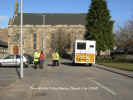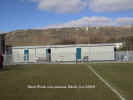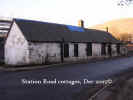On this page:

 |
Preparing for the future
|
 Map of progress 2001-2006
Map of progress 2001-2006
The decline of traditional industries such
as Calico printing, mining, Alum Works and the Nail Works resulted in loss of
employment over the years, causing a range of social, economic and environmental
issues in the village.
This was compounded, when, in more recent
times (2002), the village was dealt a major blow by the closure of Lennox
Castle Hospital, which, at its height had 800 employees. In a bid to confront
the issue of the massive job losses and the inevitable economic depression, a
task force funded by the East Dunbartonshire Council, Scottish Enterprise
Dunbartonshire and Greater Glasgow Primary Care National Health Service (N.H.S) Trust was set up.
This then resulted
in the establishment of the Lennoxtown Initiative in 2001-2002.
Project
Team and Analysis
Following this, a project team which
comprised Land Use Consultants (LUC), and Small Town and Rural Development group
(STAR), was appointed to work alongside Lennoxtown Initiative and the local
community, to prepare a village design brief; a framework for the physical
regeneration of Lennoxtown over the next 5-10 years. The
team, led by LUC, was commissioned on June 21st 2005, and work was expected to
be completed by late Autumn 2005.
The Project was afforded an opportunity to
systematically analyze the weaknesses, strengths, and potential of the village,
reflect the views, needs and priorities of the local community, and develop a
framework to guide future developments.
From their analysis, they gleaned
information about the physical and environmental characteristics and
qualities of the village, by assessing architecture, road, footpaths, green spaces, and
associated infrastructure. Road signs, and the nature and quality of
village
entrances or gateways were also assessed. Areas of historical interest,
including the industrial history of the area were analyzed, as were recreational
access, linkages to the Campsie Fells, Glazert Water and neighbouring villages.
This is not an exhaustive list! *
It was thought that this analysis and the
views of the community, could provide a structural plan; a basis for development of the village.
Indeed, the remit of the Initiative, which was in
part funded by the sale of the hospital land, was to regenerate the village;
this regeneration presents a major challenge.

Meetings
At the outset, the first task was to meet the client group with a view to exploring method and
approach, and to discuss the aspirations of the client group. Afterwards, existing information
was drawn from other available sources, such as census data, Lennoxtown
Initiative, East Dunbartonshire Council and/or Scottish Enterprise
Dunbartonshire. They mapped existing retail, leisure and community facilities,
for example, education, police, health etc., public transport provision, and village
facilities, with the intention of identifying areas where services were
deficient.
In the first round of meetings the group
met with members of the community council, churches, playgroups, clubs,
retailers and other businesses, schools, police, and the local councillor, and
focused on collecting information about the village and residents
expectations for future development. These meetings and consultations
included face-to-face meetings, and small focus group discussions, each with a different
remit.
Community workshops were undertaken to
explore the results of the analysis and the draft framework, and everyone
involved in the initial rounds of consultation was invited to attend. Following
this, the group was able to define and prioritize strategies for Lennoxtown,
and confirm priority actions and projects. These were then combined in a final
report tailored to the needs of the Initiative and its partner organizations.

 |
Regeneration begins
|
Over the last year signs of the physical regeneration of Lennoxtown have been
apparent. In Station Road, the construction of the new business centre is well
under way, and is due to be completed by the end of this March 2006. This development will
have workshop units and a 2 storey pavilion.
This £1.8m investment, which is expected to provide much needed high quality
business space in the village and encourage employers to offer new jobs, is a
partnership between the Initiative, AWG, Strathclyde District Council (SDC), and
Scottish Enterprise Dunbartonshire (SED).
Regarding the Lennox Castle Residential Development, the latest report from
Lennoxtown Initiative states that it has been working with its private sector
partner, Mactaggart and Mickel and the National Health Service (NHS), the owner
of the site, in attempting to secure planning consent to build 76 houses on the
lower level of the former Lennox
Castle Hospital site.
The planning application shows a mixed use for the site, with the lower site
being residential and the upper site greenbelt compatible. Proposals for the
detailed development of the first 10 acres, of the residential site, have been
made public. This shows that the developers have favoured and indeed replicated
the 'oval' theme of the original, existing housing plan. This phase will
incorporate the 76 units mentioned
previously; the planning
application is 'pending'.
It is anticipated that a total of between 300 and 350 dwellings will be
developed, over five phases, with around 70 units being developed at each stage.
Construction is expected to commence this year (2006) subject to approval of
planning consent.
Update: On April 19th 2006, MacTaggart and Mickel were granted
planning permission for the first phase of their proposed development of the
former Lennox Castle Hospital grounds. The site, to be called Campsie View, will house
76 units in this initial stage. For further information see: Links, Mactaggart
and Mickel.
Top of page
Celtic
Football Club
On July 4th 2005, Glasgow Celtic Football Club announced that conditional
missives have been agreed for 50 acres of the former hospital site, in order to
build a sports academy and training facility. A planning application,
which was submitted on October 7th 2005, requested permission to build the
training complex on the upper level of the former hospital site. This
application has been granted, subject to various conditions, and work is expected
to commence this year (2006). This development is expected to include:
 | 3 natural grass full sized, UEFA -standard pitches, and 1 full sized
artificial UEFA-standard pitch. |
 | Indoor training facilities, with gym and fitness, physiotherapy and
medical suite. |
 | Extensive changing facilities, goal keeping training areas. |
 | Classroom/education, sports science/sports development facilities. |
 | Administration offices and media facilities. |
The recent Calico Way housing development will eventually incorporate a total
of 116 private units, with direct links to the centre of the village being
constructed for pedestrians.
Other developmental proposals include two new cottage flats at Whitefield
Terrace, and Lennox Homes - two apartment blocks with twelve 2-bedroomed units on Main
Street. Building of the apartment blocks is now nearing completion.
Consent has also been granted for development of four detached houses on the
site of the now derelict petrol station at the east end of the village.
Celtic News - Friday
April 21st 2006
The following article was obtained from Glasgow
Celtic Football Club website, and was written by Gregor Kyle.
Positive
step for Lennoxtown
"Celtic Football
Club have moved a step closer towards a new world class training facility in
Lennoxtown, after receiving detailed planning permission for the proposed
development.
The club announced plans for a new multi-million pound training facility and
sports academy in July last year and have now (Wednesday, April 19) received
detailed planning permission.
A Celtic spokesperson commented: “We received detailed planning permission
last night for the Lennoxtown development.
This is a significant step towards the realization of Lennoxtown as the
new Training Facility for Celtic Football Club. However, we still have to resolve several issues before we give the final
go ahead.”
The proposed 50 acre site for the facility is situated in the grounds of the
former Lennox Castle Hospital and news of the planning permission comes hot
on the heels of Celtic’s treble of youth, reserve and SPL championship
victories."
October 10th 2007
Today Celtic Football Club announced the official
opening of its new state-of-the-art training centre in Lennoxtown. The
Centre, which is the culmination of 2 years building, is located on a
stunning 50-acre site, which formerly housed the upper section of
Lennox-Castle Hospital.
It boasts a wealth of first class facilities, and will also have both medical
and sports science staff based on the premises.
Brian Quinn, the Celtic chairman said, “We are
absolutely delighted to officially open our new Lennoxtown Training Centre
today. This is a very important day for Celtic and one which heralds a new
era for the club.”
Gordon Strachan the Celtic Manager said, “The Centre enjoys a tremendous
location and excellent facilities and I’m sure Celtic can only benefit
from this move. It is a great day for the Club.”

 |
Lennox-Castle background and update
|
On October 28th 1993, the Kirkintilloch Herald reported that Lennox Castle
and grounds had been sold to a subsidiary of Clyde Building Group for
conversion/development into 47 flats.
Despite residential development being contrary to greenbelt policy, and
opposition from local community leaders, plans for the conversion were
submitted. This planning application was refused.
Two subsequent applications were also denied, and an appeal was eventually
lodged against the refusal of planning permission. The appeal was
successful, but obliged the owners to carry out repairs on the unkempt and
unmaintained building.
In August 1998, a repairs notice was served on the owners, but remains
outstanding. The following month, Greater Glasgow Health Board asked the
Scottish Office for approval to close the hospital by 2002. This request was
contested by the 'Friends of the Lennox Castle' pressure group.
The Scottish Civic Trust was informed the East Dunbartonshire Council was
considering serving a dangerous Buildings notice.
By October 1998, remedial work was estimated at £17,000 - £25,000, and full
stabilization at £240,000. Local planners indicated that Dunbartonshire
Enterprise was prepared to contribute to a feasibility study of the castle.
On April 28th 1999, the Kirkintilloch Herald reported the castle had been
placed on the 'Buildings at Risk' Bulletin. By November 2001, there was evidence
that many of the interior [structures] had collapsed. The property was fenced
off and a security guard was in attendance.
The Kirkintilloch Herald again reported on June 5th 2002, that the castle was
once more included in the Buildings at Risk register 2002-2003.
Historic Scotland reported in October 2003 that plans had been lodged for the
conversion of the castle to flats.
A prospective new buyer has shown interest in the Castle, Woodhead House and
the old Co-operative building on the Main Street. Negotiations are ongoing.

High Church background and update
The High Church was devastated by fire in 1983. Immediately following this,
an application for demolition was submitted, but permission was refused.
The building was inspected in July 1990 and revealed it as a roofless but stabilized
building. Attempts by the District Council to prevent vandalism were
unsuccessful, and the prospect of demolition loomed if funds for repairs were
not forthcoming.
The Council were unable to trace the owner, so wrote to the Scottish
Secretary to ensure preservation of the building's remains. Local councillors
appealed to the Planning Committee for funds to prevent further deterioration,
and Community Councils in the district were asked for their thoughts on the
future of the church.
External inspection of the building in 1993, revealed clear evidence of
structural distress. Sandstone blocks had been removed from the bottom of the
west wall, causing destabilization. Historic Scotland visited the site, and a
response from them was anticipated.
In 1994, Strathclyde Building Preservation Trust prepared a feasibility study
into the preservation and stabilization of the church. This study was approved
by the District Council and Scottish Building Preservation Trust assumed
temporary ownership of the church with the intention of transferring it to the
Council upon completion of any work. The district Council's Heritage Fund agreed
in principle to a financial allocation towards the cost of the work, and other
sources of finance were to be investigated. However, these plans suffered a
setback in May 1995 when Historic Scotland rejected a grant aid application. The
application was re-submitted.
Stabilization of the building was estimated at £161,000, and funding for it
was secured from the European regional Development Fund. Plans to rebuild the
church tower were put on hold in preference to the preservation of the existing
building.
Some investigations into community use of the church as a museum or library
were considered. Strathclyde Building Preservation trust and East Dunbartonshire
Council continued to work on the project.
External inspection in February 2001 revealed the church remains at risk, and
by February 2004, Glasgow Building Preservation trust was approached to conduct a
feasibility study into re-use or consolidation as a ruin.
The present owner of the church, has very
kindly offered to return the building to the safe keeping of the community
whenever finance for its restoration can be secured, and the reconstruction is
complete. The primary consideration for the community would then be major
security to ensure that no further damage befalls this magnificent building.
The local community have recently set up a Heritage Preservation Trust in
order to restore the building. The initial aim of the trust will be to install
floodlighting, access and power, and restore the clock and clock tower. In
addition, the trust will investigate potential re-use for the building.
One proposal for new -use is as a practice
area for climbers - within the church!
Other buildings of interest to the Trust are Woodhead House
(see Lennox Family), and the original
Co-operative building in the Main Street opposite the new Co-op premises.

Physical Regeneration
Framework and Action Plan
Amongst the items outlined by Land Use Consultants (LUC), and Small Town and Rural
Development group
(STAR), in their Action plan for Lennoxtown and the Clachan- of - Campsie was
their acknowledgement of the unique potential of the area, and their
recommendations for maximizing this.
To capitalize on the setting they envisage
a new Campsie Glen Country Park - a local Nature Reserve, and Lennoxtown as a
services centre for outdoor pursuits and leisure activities.
It is anticipated that Lennoxtown will
invigorate itself around a new focal centre, namely a new Public Square, and a
multi-purpose Community Centre - a place developed by the community for the
community. This Community facility may include developments such as; clinic,
library, police station, pharmacy and Council Offices.
To put the heart back into Lennoxtown, the
Main Street, particularly the area around Station Road and the Town Hall will be
re-vitalized. The district will have clear, welcoming approaches, hopefully
reflecting the sense of community ownership. Shortfalls in leisure and
sports facilities, such as bowling, golf and football, will also be addressed,
as will childcare provision.
Delivery of environmental improvements is
dependent on funds being generated from the Sale of the former Lennox Castle
Hospital grounds. It is expected that the N.H.S will re-invest some of that
money into the village. Without it, none of the above objectives can be
achieved.
Below is a copy of the statement issued by
the Scottish Executive:-
March 28, 2003
Scottish
Executive give green light to "Legacy for Lennoxtown"
"The Scottish Executive has given the green light to a £3.5
million 'legacy for Lennoxtown' from the sale of land at the former
Lennox Castle Hospital.
In a letter to the Great Glasgow Primary Care NHS
Division, Finance Minister Andy Kerr and Health Minister Malcolm Chisholm
endorsed the Division's decision to reinvest cash raised from the sale of land
at the Lennox Castle site in projects developed by the community-led Lennoxtown
Initiative.
The money will be matched by funds from Scottish
Enterprise Dunbartonshire and East Dunbartonshire Council and will allow
large-scale regeneration projects to go ahead in the village.
Although the Lennoxtown Initiative was launched last May
(2002), it
has taken until now (2003) to get the all clear for cash from the sale of hospital land
to be reinvested in the community. In the intervening months a wide-ranging
community consultation exercise has been going on and an action plan is being
developed."
Over the following 5 years, the Initiative expected to generate
approximately 250 jobs, with another 150 projected from the £3.5 million
(statement from press says £40) re-development of the former Lennox-Castle
Hospital site and additional construction opportunities. It hopes to safeguard a
further 70 jobs, and 850 local residents are expected to participate in learning
and development programmes.
Top of page

Mobile Police Station
(MPS)
A new Mobile Police Station or 'Bobby Bus' was introduced to Lennoxtown in
March.
This state-of
-the-art vehicle is for use by all rural areas, and not especially for
Lennoxtown. It will be staffed by community police officers and used
to service the villages of Milton-of-Campsie, Twechar, Torrance, and surrounding
areas - as well as Lennoxtown! The vehicle will be based at Kirkintilloch Police
Station, but Superintendent Andy Bates was quoted in the Kirkintilloch Herald,
March 29th 2006, as saying that, " Police officers will use the vehicle to
provide a base for contact with communities on a regular and planned basis, to
suit the needs of local people."
This new service will allow villagers to raise local issues whilst at the
same time provide additional services such as prevention of crime advice,
discussion of concerns, and passing on and receiving information of interest.
Locals should be able to meet duty policemen; which will, hopefully, provide
reassurance and assist in the reduction of fear of crime.
The Lennoxtown MPS induction ceremony took place in Chapel Street on
March 21st, 2006. Mr. John Dempsey and Mr. Charles Kennedy were in
attendance. Picture below.


 |
New Premises for Black Watch Football Team
|
The Station Road cottages, which for many years served as the dressing rooms
for Campsie Black Watch, were demolished in December 2005, and have now been
replaced by state-of-the-art portakabins. It is hoped that the portakabins which
are sited next to the Black Watch football pitch in the Field Park, will be a
permanent fixture.
An assistant/ associate of the team, Mr. John Mann was extremely enthusiastic
about the move to the new premises, and took great pride in showing them to
visitors on March 21st 2006. He was very positive and generous in his praise of
Mr. Marley and the team.
It seems unfortunate that the unique cottages were demolished so hastily,
since they had a history dating back to the 1700's, and as football
dressing rooms had been used by some very prestigious players and teams. They
could perhaps have served as a little museum to the village or the football
club, but it may be that they stood in the way of progress. These are questions
which will need to be asked of the planners!
Campsie Black Watch is one of - if not the most successful Juvenile Teams
ever, but we in Lennoxtown began to take the success for granted and became a
little complacent over the years. However, villagers rallied to support Mr.
Marley in his recent attempts for better accommodation, and it goes without
saying, that all wish him, his players and assistants the very best of luck in
the new accommodation.


New changing
facilities
Old changing facilities

 |
Campsie Pigeon Club
|
Campsie Racing Pigeon Club have been granted planning permission for
temporary club facilities adjoining the temporary sports changing rooms for
Campsie Black Watch Football Club. The site is adjacent to Campsie Black Watch
football ground

 |
Mountain Bike Trail
|
Its would appear that Lennoxtown is now becoming a popular destination for
mountain bike riders. One young man, Neil form Glasgow, has a Web site on which
he talks about Lennoxtown forest, (along the back road to the Castle, and behind
the Oval houses) as having an "Awesome natural singletrack, unbelievable
northshore (not for me), and a whole heap of mud. For anyone based in the
Glasgow area with a passion for natural singletrack, get up to Lennoxtown as
soon as you can. Hardly a rider in sight and a fantastic network of trails. Just
explore and you will love it."
He adds, "Have fun and get on your bike - nothing better."
Can the environment withstand this type of activity, without causing too much
damage? Should we be encouraging others to join Neil, or should we discourage
them?
Top of page

Morris
update
Having previously described Morris as possessing the 'Midas touch' (see History
Morris Furniture) seemed uncannily prophetic, when 'The Mail on Sunday',
April 23rd 2006, announced Mr. Robert Morris was about to become richer by £35.66m.
Initially he was told he could expect £15million in compensation for moving
his Glasgow Headquarters to make way for the M74 extension. However, following a
controversial 'unrecorded' meeting with the First Minister, Jack McConnell, the
Scottish Executive more than doubled the offer to £35.66m.
The meeting with Mr. Morris and the First Minister, was described as an
'informal discussion', but Mr. McConnell's role in the huge compensation award,
revealed in letters released under the Freedom of Information Act, will now come
under intense scrutiny, with politicians demanding explanations.
Mr. Morris had been in contact with the First Minister since 2003, claiming
the compensation offered was £25 million short, and he applied pressure on Mr.
McConnell in September 2004 by writing, "Unless an immediate and
early conclusion of our discussions can be achieved, the consequences of your
Executive's inaction over the last 18 months will be catastrophic for this
business"
If a satisfactory solution had not been reached, and the company had
re-located to England or had closed down, Mr. McConnell's political
reputation would no doubt have been damaged. But he isn't out of the woods yet,
now we need to wait to see if he can withstand the public scrutiny, offer
acceptable explanations and escape unscathed from this affair
History
Campsonians Lennox Family Churches
Cholera
Strike
White fields
Points of Interest
Photo Album Population
Memories The future Bibliography Links   

Return
to top of page
| 














